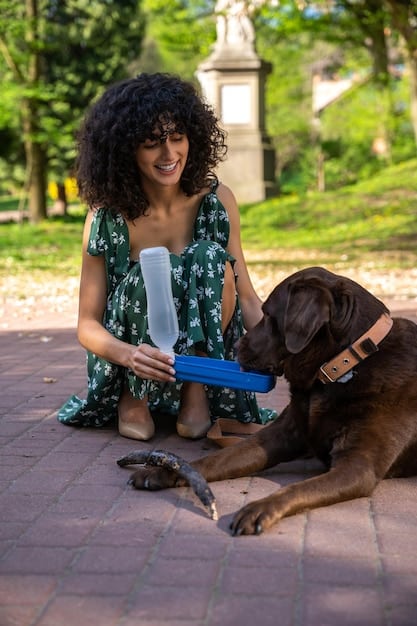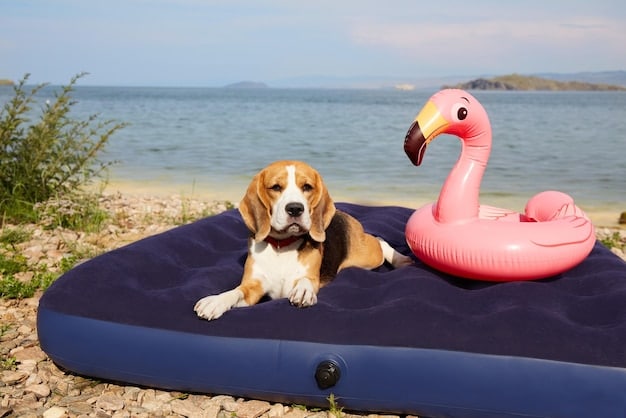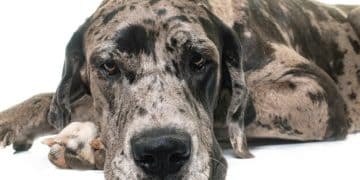Protect Your Pet From Heatstroke: Essential Summer Safety Tips

Protecting your pet from heatstroke is crucial during the summer; this means understanding heatstroke symptoms, providing constant access to fresh water and shade, and knowing when to seek immediate veterinary care to ensure your dog’s safety and well-being.
Summer is a wonderful time for outdoor activities with your furry friend, but it also presents the risk of heatstroke. It’s essential to protect your pet from heatstroke by taking proactive measures to ensure their safety and well-being during hot weather.
Understanding Heatstroke in Dogs
Heatstroke, also known as hyperthermia, is a life-threatening condition that occurs when a dog’s body temperature rises to dangerous levels. Unlike humans, dogs can’t sweat effectively to cool down, making them more susceptible to overheating. Understanding the causes and symptoms of heatstroke is the first step in protecting your beloved companion.
Causes of Heatstroke in Dogs
Several factors can contribute to heatstroke in dogs. Exposure to high temperatures, lack of shade, inadequate water intake, and strenuous exercise during hot weather are common causes. Leaving a dog in a parked car, even for a few minutes, can quickly lead to heatstroke, as the temperature inside a vehicle can rise rapidly.
Recognizing the Symptoms
Early detection of heatstroke symptoms is critical. Key signs include excessive panting, difficulty breathing, increased heart rate, drooling, weakness, and stumbling. In severe cases, dogs may experience vomiting, diarrhea, seizures, and loss of consciousness. If you notice any of these symptoms, it’s essential to take immediate action.

To prevent heatstroke, avoid intense exercise during the hottest parts of the day and always provide access to fresh, cool water. Never leave your dog unattended in a car, even with the windows slightly open.
Heatstroke in dogs is a serious concern for pet owners, particularly during the summer months. Recognizing the causes and symptoms, as well as taking preventive measures, can significantly reduce the risk. By understanding how heatstroke affects your dog, you can ensure their safety and well-being throughout the summer season. Keeping your dog cool, hydrated, and protected from excessive heat is paramount.
Providing Adequate Hydration
Proper hydration is crucial for preventing heatstroke in dogs. Ensuring your dog has constant access to fresh, cool water is one of the simplest yet most effective ways to keep them safe during hot weather. Dehydration can exacerbate the effects of heat, making it harder for dogs to regulate their body temperature.
Always have a water bowl available, whether at home or on the go. Use collapsible bowls for easy transport during walks or outings. Consider adding ice cubes to the water to keep it cool, especially during the hottest parts of the day. Make sure to refill the bowl frequently to ensure the water is always fresh and accessible.
- Offer Water Frequently: Encourage your dog to drink regularly, especially after exercise.
- Portable Water Bowls: Carry a collapsible bowl and water bottle on walks.
- Electrolyte Solutions: Consult with your vet about electrolyte solutions for extreme heat.
Hydration is a cornerstone of heatstroke prevention. By ensuring your dog has access to fresh, cool water at all times, you can significantly reduce the risk of overheating. Remember, hydration is not just about providing water—it’s about encouraging your dog to drink regularly and making it convenient for them to do so.
Creating Shady Retreats
Dogs need shade to escape the direct sun, especially during peak hours. Creating shady retreats both indoors and outdoors is essential for keeping them cool and comfortable. Without shade, dogs can quickly overheat, leading to heatstroke. Whether you’re at home, in the park, or on a hike, always ensure your dog has access to a shaded area.
Outdoor Shade Options
When outdoors, look for natural shade provided by trees or buildings. If natural shade is limited, create your own using umbrellas, tarps, or portable shelters. Ensure the shaded area is large enough for your dog to lie down and move around comfortably. Regularly check the temperature of the shaded area to ensure it remains cool.
Indoors, ensure your dog has access to cooler areas of the house, such as tile or hardwood floors, where they can lie down and dissipate heat. Consider using fans or air conditioning to keep the indoor environment cool.
- Natural Shade: Utilize trees and natural structures.
- Portable Shelters: Bring umbrellas or tarps for shade.
- Indoor Cooling: Use fans or air conditioning.

Creating shady retreats is an indispensable part of heatstroke prevention. By ensuring your dog has access to shade both indoors and outdoors, you can help them regulate their body temperature and stay comfortable during hot weather. Providing shade is a simple yet effective way to protect your dog from the dangers of overheating.
Adjusting Exercise Routines
Exercise is important for your dog’s physical and mental health, but it’s crucial to adjust exercise routines during hot weather to prevent overheating. Strenuous activity can quickly raise a dog’s body temperature, increasing the risk of heatstroke. By making smart choices about when and how you exercise your dog, you can keep them safe and healthy throughout the summer.
Timing Your Workouts
The best times for exercise are early morning or late evening when temperatures are cooler. Avoid exercising your dog during the hottest parts of the day, typically between 10 a.m. and 4 p.m. Check the pavement temperature before walking your dog, as hot surfaces can burn their paws. If it’s too hot for you to walk barefoot, it’s too hot for your dog.
Choosing Low-Impact Activities
Opt for low-impact activities such as swimming, walking in shaded areas, or playing fetch in a pool. Avoid activities that require intense running or jumping, which can quickly lead to overheating. Pay close attention to your dog’s behavior during exercise. If they start panting excessively, slow down or stop and find a cool place to rest.
Providing Cooling Breaks
Take frequent breaks during exercise to allow your dog to cool down and rehydrate. Offer water regularly and consider using a cooling vest or wet towel to help dissipate heat. Monitor your dog for signs of heatstroke, such as excessive panting, weakness, and drooling. If you notice any of these symptoms, stop exercising immediately and seek veterinary care.
Adjusting exercise routines is vital for preventing heatstroke in dogs. By timing your workouts wisely, choosing low-impact activities, and providing cooling breaks, you can keep your dog safe and healthy during hot weather. Remember, exercise should be enjoyable for both you and your dog, so prioritize their well-being by adjusting your routine to suit the conditions.
Recognizing High-Risk Dogs
Certain dogs are more susceptible to heatstroke than others. Understanding which dogs are at higher risk can help you take extra precautions to protect them during hot weather. Factors such as breed, age, weight, and overall health can all play a role in a dog’s vulnerability to overheating.
- Brachycephalic Breeds: Bulldogs, Pugs, and Boxers are prone to overheating due to their short snouts and breathing difficulties.
- Senior Dogs: Older dogs often have underlying health conditions that make them more susceptible to heatstroke.
- Overweight Dogs: Excess weight can make it harder for dogs to regulate their body temperature.
- Dogs with Health Issues: Dogs with heart or respiratory problems are at higher risk.
Brachycephalic breeds, also known as short-nosed breeds, have a more challenging time panting effectively to cool down, making them more prone to heatstroke. Senior dogs and overweight dogs also have a harder time regulating their body temperature. Dogs with underlying health conditions, such as heart or respiratory problems, are at higher risk as well.
If you have a high-risk dog, take extra precautions to protect them from heatstroke. Avoid exercising them during the hottest parts of the day, provide plenty of shade and water, and monitor them closely for signs of overheating. Consider using cooling vests or mats to help them stay comfortable. Consult with your veterinarian for personalized advice on keeping your high-risk dog safe during the summer.
Emergency Measures for Heatstroke
Despite your best efforts, heatstroke can still occur. Knowing how to respond quickly and effectively in an emergency can save your dog’s life. Immediate action is crucial to lower their body temperature and prevent severe complications. If you suspect your dog has heatstroke, don’t hesitate to take the following steps.
Immediate Cooling Techniques
Move your dog to a cool, shaded area immediately. Use cool (not cold) water to wet their fur, focusing on the abdomen, groin, and paws. Apply a cool, wet towel to their neck and head.
Seeking Veterinary Care
Heatstroke can cause severe organ damage and even death if left untreated. Even if your dog appears to be recovering, it’s crucial to seek veterinary care as soon as possible. Your veterinarian can provide further treatment to stabilize your dog, monitor for complications, and address any underlying health issues that may have contributed to the heatstroke.
- Cool Water Application: Wet fur with cool water.
- Fan Exposure: Use a fan to enhance cooling.
- Veterinary Check: Seek immediate professional help.
Treating heatstroke at home is only a temporary measure. It’s essential to transport your dog to the nearest veterinary clinic for professional care. During transport, continue to apply cool water and monitor their condition closely.
| Key Point | Brief Description |
|---|---|
| 💧 Hydration | Ensure constant access to fresh, cool water. |
| ⛱️ Shade | Provide shady retreats indoors and outdoors to avoid direct sun exposure. |
| ☀️ Exercise | Adjust routines; exercise during cooler hours and choose low-impact activities. |
| 🌡️ Monitoring | Recognize symptoms early and seek immediate veterinary care for suspected heatstroke. |
Frequently Asked Questions (FAQs)
▼
Early signs include excessive panting, difficulty breathing, increased heart rate, and drooling. Watch for these signs, especially during and after exercise.
▼
Never leave your dog in a parked car, even with the windows open. Temperatures inside a car can rise rapidly and become deadly within minutes.
▼
Move your dog to a cool area, apply cool water to their fur, and seek immediate veterinary care. Prompt action can save their life and prevent severe complications.
▼
Yes, brachycephalic breeds like Bulldogs and Pugs, as well as senior and overweight dogs, are more susceptible. Extra care is needed to protect these dogs from heatstroke.
▼
Offer water frequently, especially after exercise or time spent outdoors. Always ensure a fresh supply is available, and consider adding ice cubes for extra cooling.
Conclusion
Protecting your dog from heatstroke requires vigilance and proactive measures. Understanding the causes and symptoms, providing adequate hydration and shade, adjusting exercise routines, and knowing how to respond in an emergency are essential. By following these tips, you can ensure your furry friend stays safe and comfortable throughout the summer months.





